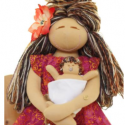
Tracy brought two and a half year old Tory who since birth had been tilting her head to one side.
At birth, Tory had been induced three weeks early with a condition called placenta accreta which means the placenta has grown so deeply into the uterine wall that it has a hard time letting go during birth without causing hemorrhaging. Usually, surgery needs to be performed so not too much blood is lost. Under some circumstances, a woman risks having to have her uterus removed.
In Tracy’s case, she was diagnosed early with something called, HELLP, which is a form of pre-eclampsia involving high blood pressure, increased liver enzymes, and lowered platelet count. In some pre and perinatal obstetric circles, it is considered a form of rejection of the mother’s body to being pregnant, even though it usually shows up in the third trimester.
Because of her condition, Tracy had to have a Cesarean section three weeks early so to avoid further increase in her blood pressure and other health complications that can arise. Tracy was blessed in that her uterus was undamaged by the placenta accreta, so she did not have to have a hysterectomy.
Tory was in a breach position, bottom down, at the time of the Cesarean. And Richard, a very devoted father and husband, was away on business at the time. No one knew this would happen so early, and his plan was to be home within plenty of time for his daughter’s birth.
During our first session, Tory picked up a doll of a pregnant mother who has a little baby who comes out of a pocket in her belly.
As Tory played, she positioned the doll foot first rather than head down as she showed us how babies get born. She repeated the movements with the doll as I worked on her body with my hands. I kept saying to her, “oh this is what it was like for you”. “Thank you for showing me.”
The baby doll continued to be born foot first until I asked Tory, “Tory what have you always wished could have happened?” Tory turned the doll head down, turned to her mother, and asked, “Where’s the Daddy? Where’s the Daddy?”
Tracy broke into tears, she had never told Tory that her Daddy had been away for work and had missed her birth. It had been a terrible heartache for both parents that they couldn’t be together when Tory came into the world.
While Tory asked these questions to her mother and her mother cried, Tory’s neck tension let go in my hands, as did her shoulder.
When people involved in any overwhelming circumstance fail to grieve, it is often the case that children will hold the unrequited grief in their bodies, thinking it is theirs. Because babies come into the world unaware that they are separate from their mothers, their mothers feelings get taken as their own and are superimposed over their own feelings.
Tracy’s ability to admit to herself how painful it was to go through such a big experience without her husband (something she had been managing quietly on her own until the session) helped her daughter release long-standing postural changes in her neck. Tory’s ability to connect with how she wished her birth could be, allowed her mother’s similar wishes to surface and be validated.
I never saw the family again. My hunch was that what happened in the session so thoroughly defied what Tracy believed to be possible, that it scared her even though it brought relief. I do trust though that children, and their families, even after one session like this, are better able to reclaim the ease they earned through repatterning their history.
Excerpt from my upcoming book on healing prebirth and birth imprints.

